Angel Walk Restaurant: A Comprehensive Business Plan (MGMT20132)
VerifiedAdded on 2022/10/19
|17
|3088
|402
Report
AI Summary
This report presents a comprehensive business plan for the Angel Walk Restaurant, a Chinese restaurant located in Sri Lanka. It begins with an executive summary and table of contents, followed by an introduction outlining the restaurant's objectives and market position. The discussion section delves into the business model, including key partners, activities, customer relationships, channels, cost structure, and revenue streams. The value proposition development focuses on providing authentic Chinese meals and exceptional service. Business operations development covers customer acquisition, overall economics, product unit economics, sales strategies, and scaling plans. The supply chain development outlines sourcing, preparation, and service processes, including technological integrations. Competitive advantages, such as low competition and experienced ownership, are highlighted. The financial value capture section includes start-up capital, expenses, and break-even analysis. The report concludes with a strategic fit assessment and recommendations for the restaurant's success.
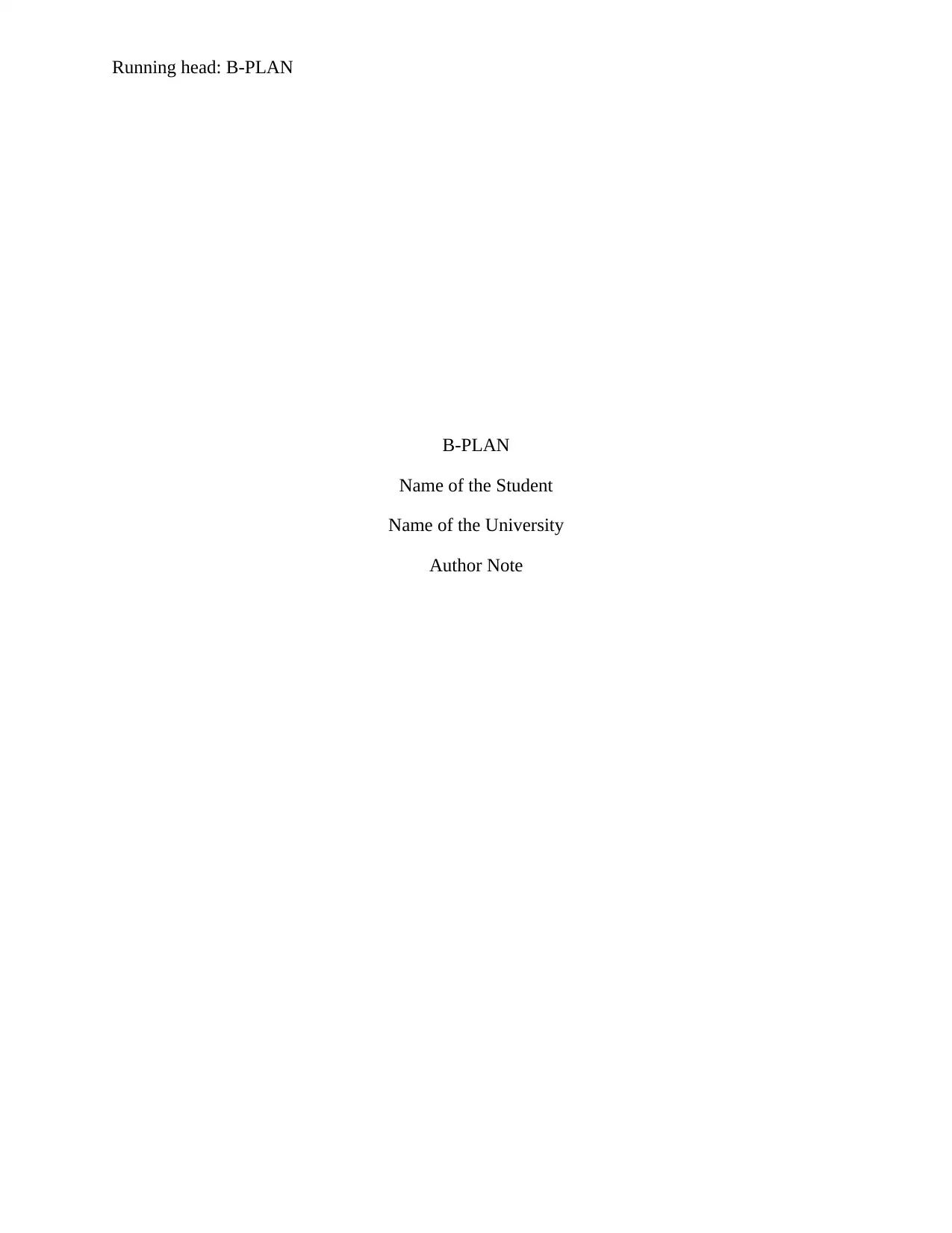
Running head: B-PLAN
B-PLAN
Name of the Student
Name of the University
Author Note
B-PLAN
Name of the Student
Name of the University
Author Note
Paraphrase This Document
Need a fresh take? Get an instant paraphrase of this document with our AI Paraphraser
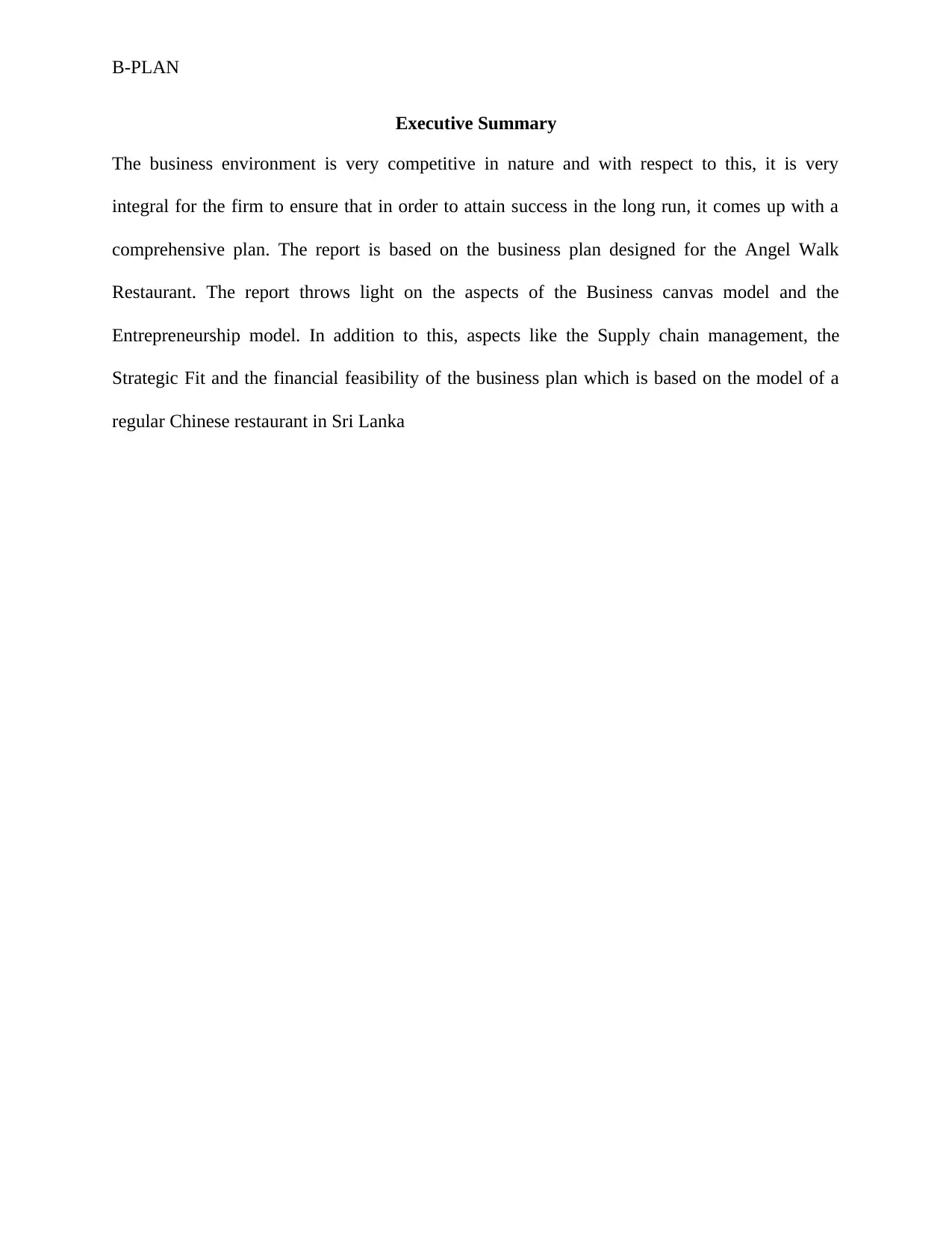
B-PLAN
Executive Summary
The business environment is very competitive in nature and with respect to this, it is very
integral for the firm to ensure that in order to attain success in the long run, it comes up with a
comprehensive plan. The report is based on the business plan designed for the Angel Walk
Restaurant. The report throws light on the aspects of the Business canvas model and the
Entrepreneurship model. In addition to this, aspects like the Supply chain management, the
Strategic Fit and the financial feasibility of the business plan which is based on the model of a
regular Chinese restaurant in Sri Lanka
Executive Summary
The business environment is very competitive in nature and with respect to this, it is very
integral for the firm to ensure that in order to attain success in the long run, it comes up with a
comprehensive plan. The report is based on the business plan designed for the Angel Walk
Restaurant. The report throws light on the aspects of the Business canvas model and the
Entrepreneurship model. In addition to this, aspects like the Supply chain management, the
Strategic Fit and the financial feasibility of the business plan which is based on the model of a
regular Chinese restaurant in Sri Lanka
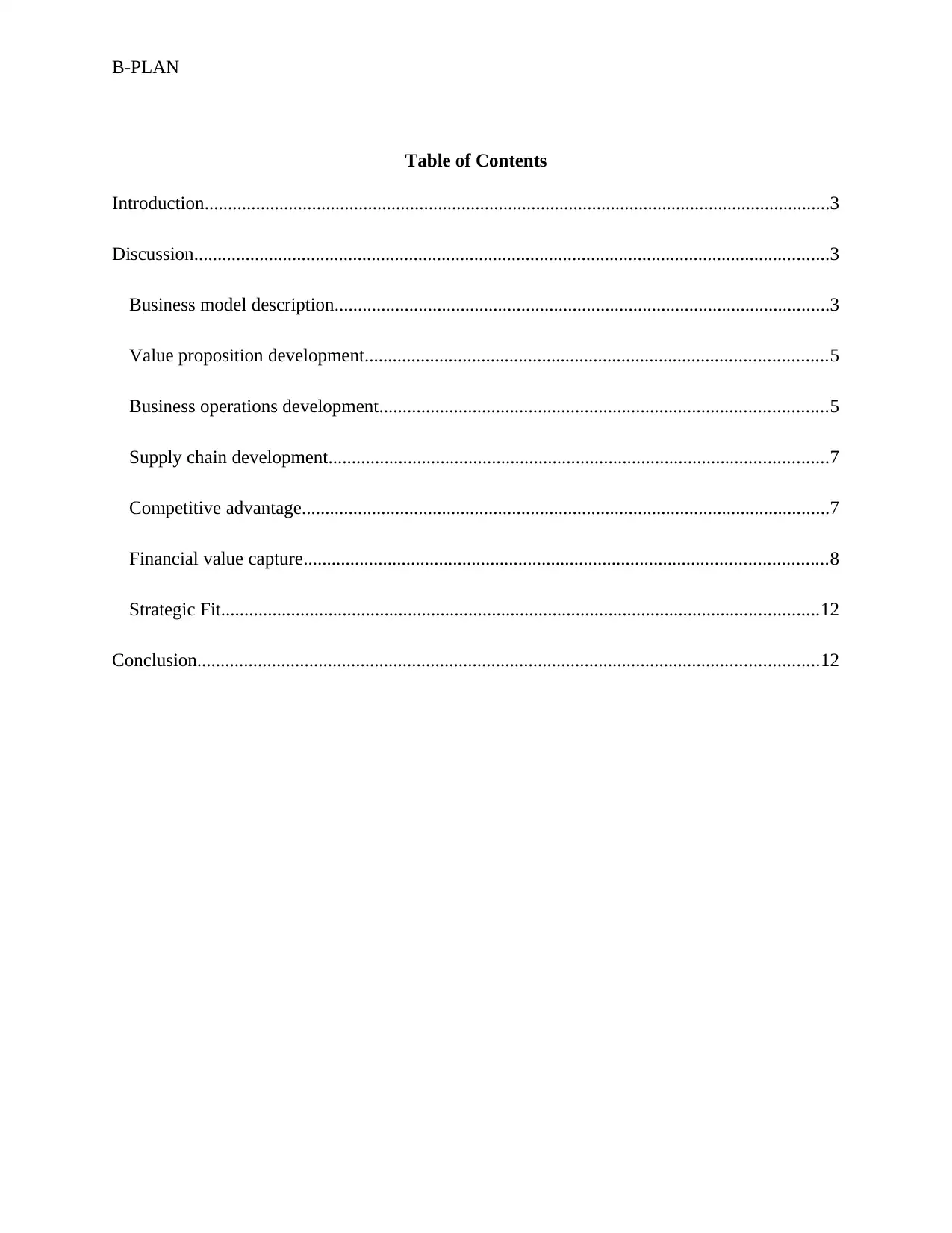
B-PLAN
Table of Contents
Introduction......................................................................................................................................3
Discussion........................................................................................................................................3
Business model description..........................................................................................................3
Value proposition development...................................................................................................5
Business operations development................................................................................................5
Supply chain development...........................................................................................................7
Competitive advantage.................................................................................................................7
Financial value capture................................................................................................................8
Strategic Fit................................................................................................................................12
Conclusion.....................................................................................................................................12
Table of Contents
Introduction......................................................................................................................................3
Discussion........................................................................................................................................3
Business model description..........................................................................................................3
Value proposition development...................................................................................................5
Business operations development................................................................................................5
Supply chain development...........................................................................................................7
Competitive advantage.................................................................................................................7
Financial value capture................................................................................................................8
Strategic Fit................................................................................................................................12
Conclusion.....................................................................................................................................12
⊘ This is a preview!⊘
Do you want full access?
Subscribe today to unlock all pages.

Trusted by 1+ million students worldwide
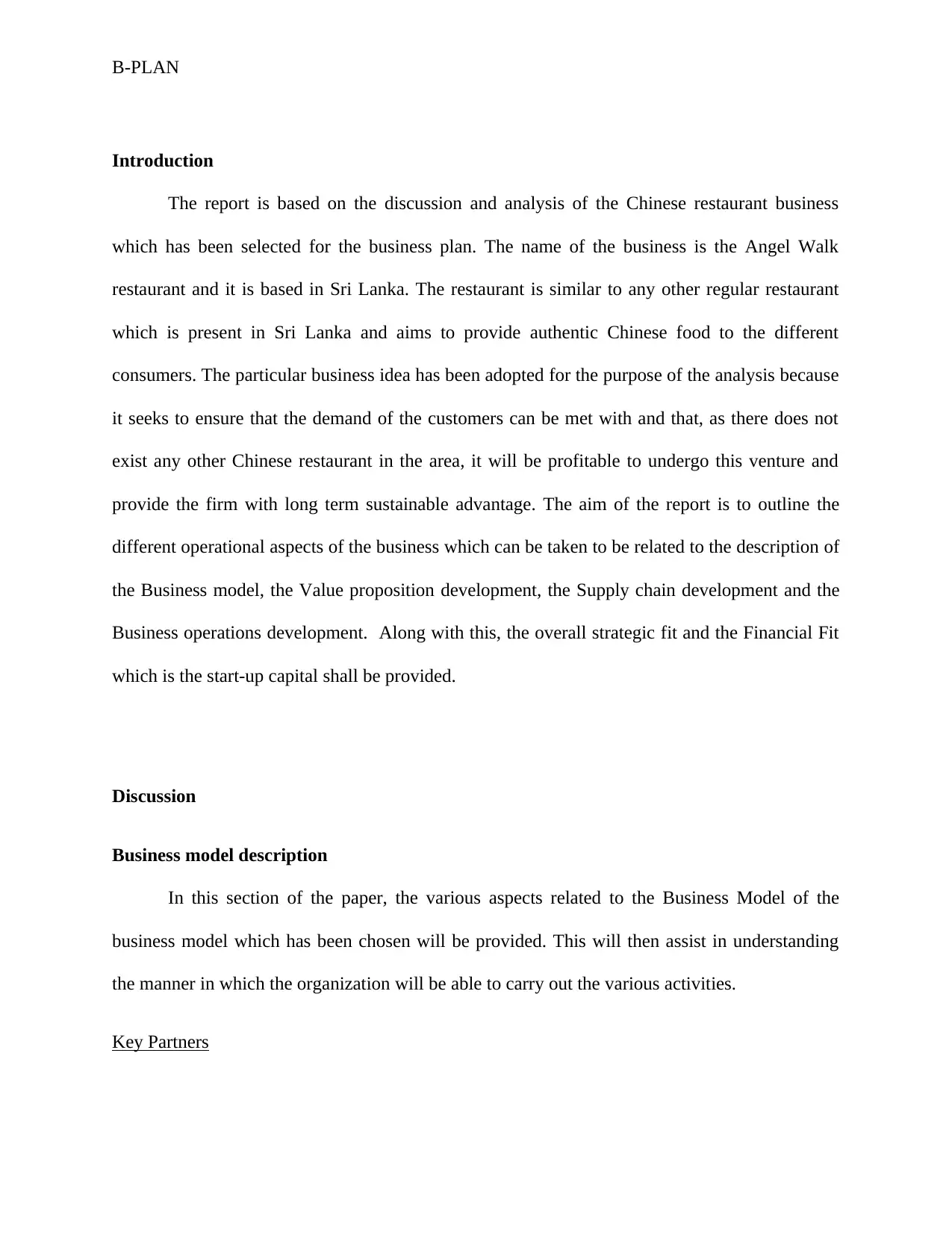
B-PLAN
Introduction
The report is based on the discussion and analysis of the Chinese restaurant business
which has been selected for the business plan. The name of the business is the Angel Walk
restaurant and it is based in Sri Lanka. The restaurant is similar to any other regular restaurant
which is present in Sri Lanka and aims to provide authentic Chinese food to the different
consumers. The particular business idea has been adopted for the purpose of the analysis because
it seeks to ensure that the demand of the customers can be met with and that, as there does not
exist any other Chinese restaurant in the area, it will be profitable to undergo this venture and
provide the firm with long term sustainable advantage. The aim of the report is to outline the
different operational aspects of the business which can be taken to be related to the description of
the Business model, the Value proposition development, the Supply chain development and the
Business operations development. Along with this, the overall strategic fit and the Financial Fit
which is the start-up capital shall be provided.
Discussion
Business model description
In this section of the paper, the various aspects related to the Business Model of the
business model which has been chosen will be provided. This will then assist in understanding
the manner in which the organization will be able to carry out the various activities.
Key Partners
Introduction
The report is based on the discussion and analysis of the Chinese restaurant business
which has been selected for the business plan. The name of the business is the Angel Walk
restaurant and it is based in Sri Lanka. The restaurant is similar to any other regular restaurant
which is present in Sri Lanka and aims to provide authentic Chinese food to the different
consumers. The particular business idea has been adopted for the purpose of the analysis because
it seeks to ensure that the demand of the customers can be met with and that, as there does not
exist any other Chinese restaurant in the area, it will be profitable to undergo this venture and
provide the firm with long term sustainable advantage. The aim of the report is to outline the
different operational aspects of the business which can be taken to be related to the description of
the Business model, the Value proposition development, the Supply chain development and the
Business operations development. Along with this, the overall strategic fit and the Financial Fit
which is the start-up capital shall be provided.
Discussion
Business model description
In this section of the paper, the various aspects related to the Business Model of the
business model which has been chosen will be provided. This will then assist in understanding
the manner in which the organization will be able to carry out the various activities.
Key Partners
Paraphrase This Document
Need a fresh take? Get an instant paraphrase of this document with our AI Paraphraser
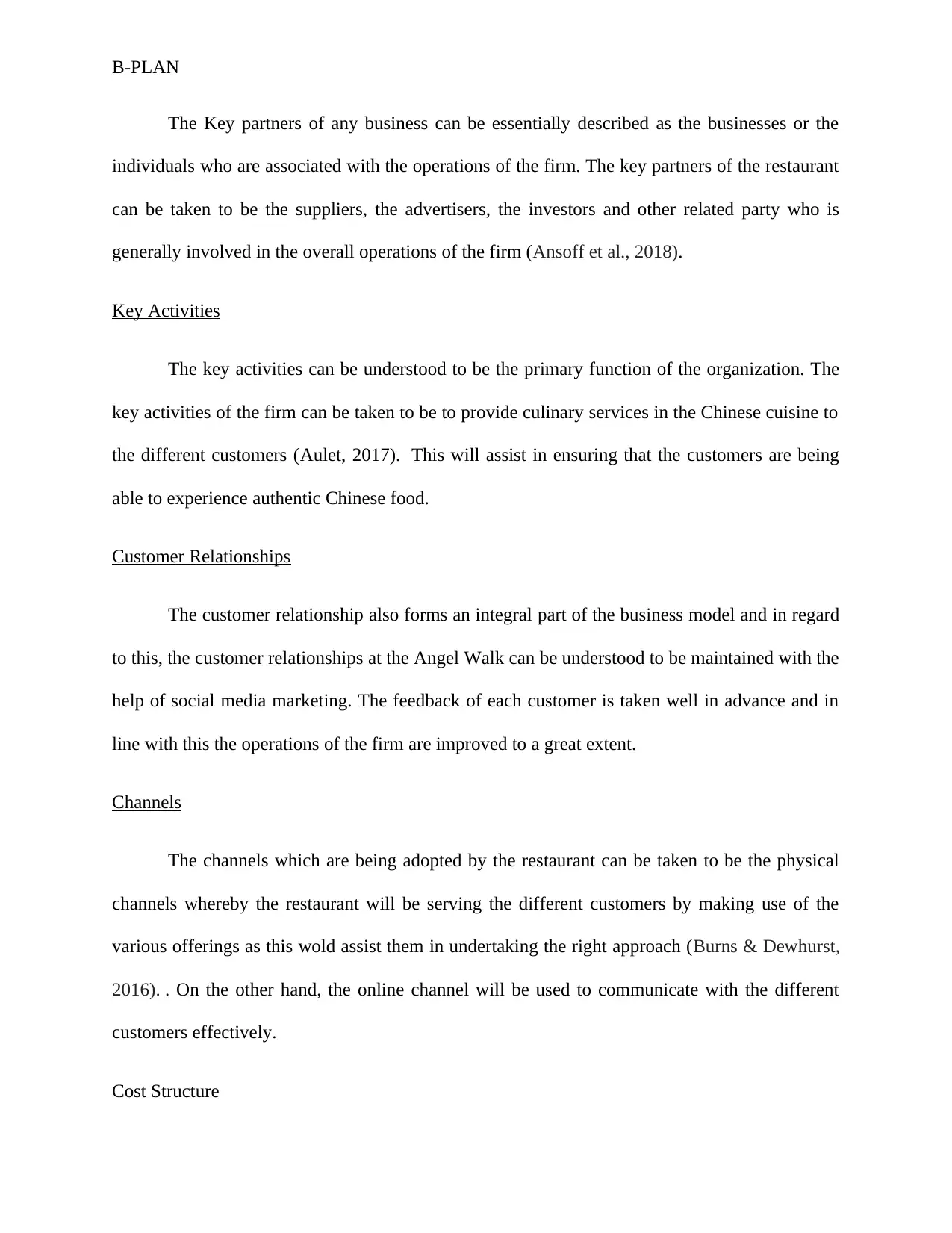
B-PLAN
The Key partners of any business can be essentially described as the businesses or the
individuals who are associated with the operations of the firm. The key partners of the restaurant
can be taken to be the suppliers, the advertisers, the investors and other related party who is
generally involved in the overall operations of the firm (Ansoff et al., 2018).
Key Activities
The key activities can be understood to be the primary function of the organization. The
key activities of the firm can be taken to be to provide culinary services in the Chinese cuisine to
the different customers (Aulet, 2017). This will assist in ensuring that the customers are being
able to experience authentic Chinese food.
Customer Relationships
The customer relationship also forms an integral part of the business model and in regard
to this, the customer relationships at the Angel Walk can be understood to be maintained with the
help of social media marketing. The feedback of each customer is taken well in advance and in
line with this the operations of the firm are improved to a great extent.
Channels
The channels which are being adopted by the restaurant can be taken to be the physical
channels whereby the restaurant will be serving the different customers by making use of the
various offerings as this wold assist them in undertaking the right approach (Burns & Dewhurst,
2016). . On the other hand, the online channel will be used to communicate with the different
customers effectively.
Cost Structure
The Key partners of any business can be essentially described as the businesses or the
individuals who are associated with the operations of the firm. The key partners of the restaurant
can be taken to be the suppliers, the advertisers, the investors and other related party who is
generally involved in the overall operations of the firm (Ansoff et al., 2018).
Key Activities
The key activities can be understood to be the primary function of the organization. The
key activities of the firm can be taken to be to provide culinary services in the Chinese cuisine to
the different customers (Aulet, 2017). This will assist in ensuring that the customers are being
able to experience authentic Chinese food.
Customer Relationships
The customer relationship also forms an integral part of the business model and in regard
to this, the customer relationships at the Angel Walk can be understood to be maintained with the
help of social media marketing. The feedback of each customer is taken well in advance and in
line with this the operations of the firm are improved to a great extent.
Channels
The channels which are being adopted by the restaurant can be taken to be the physical
channels whereby the restaurant will be serving the different customers by making use of the
various offerings as this wold assist them in undertaking the right approach (Burns & Dewhurst,
2016). . On the other hand, the online channel will be used to communicate with the different
customers effectively.
Cost Structure
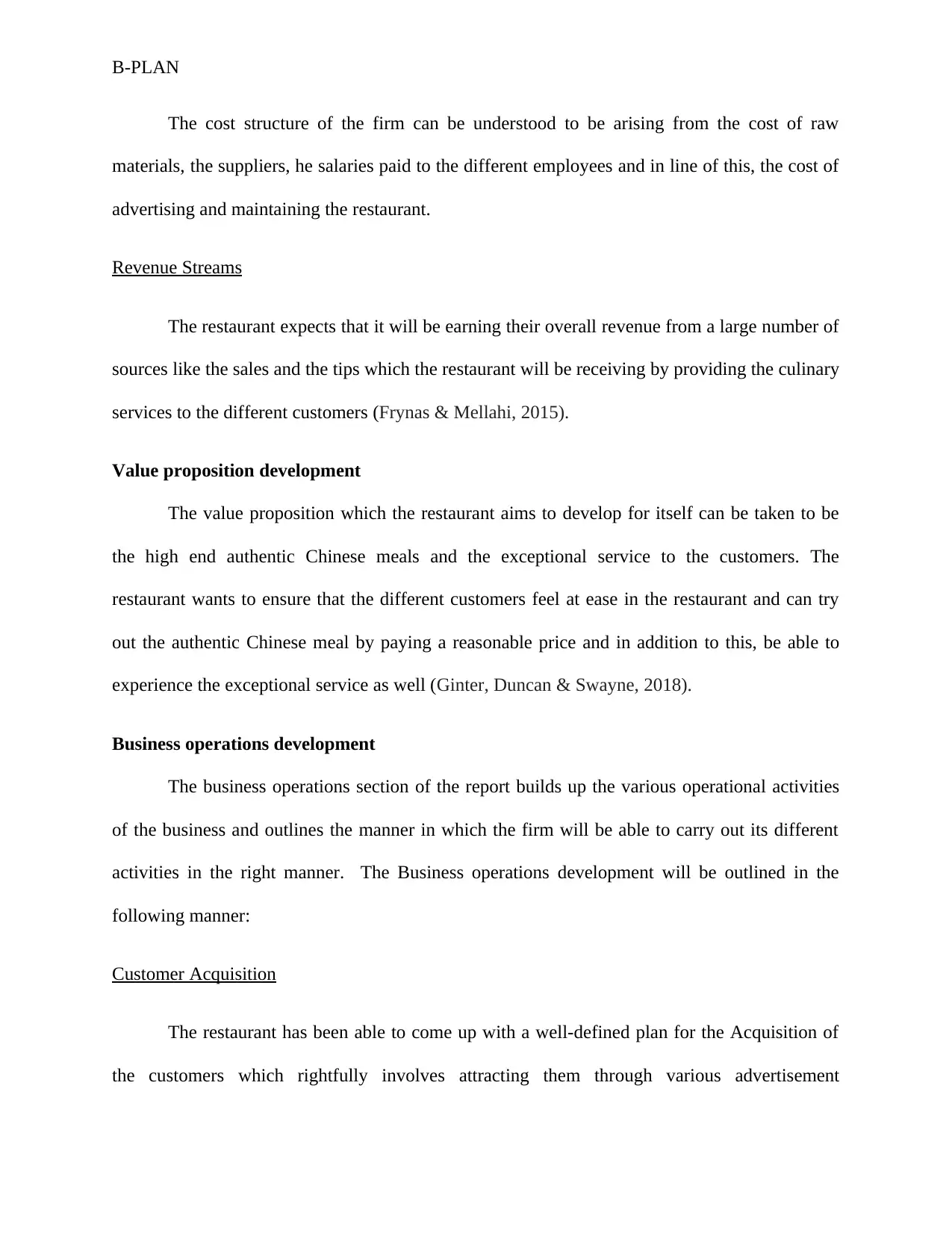
B-PLAN
The cost structure of the firm can be understood to be arising from the cost of raw
materials, the suppliers, he salaries paid to the different employees and in line of this, the cost of
advertising and maintaining the restaurant.
Revenue Streams
The restaurant expects that it will be earning their overall revenue from a large number of
sources like the sales and the tips which the restaurant will be receiving by providing the culinary
services to the different customers (Frynas & Mellahi, 2015).
Value proposition development
The value proposition which the restaurant aims to develop for itself can be taken to be
the high end authentic Chinese meals and the exceptional service to the customers. The
restaurant wants to ensure that the different customers feel at ease in the restaurant and can try
out the authentic Chinese meal by paying a reasonable price and in addition to this, be able to
experience the exceptional service as well (Ginter, Duncan & Swayne, 2018).
Business operations development
The business operations section of the report builds up the various operational activities
of the business and outlines the manner in which the firm will be able to carry out its different
activities in the right manner. The Business operations development will be outlined in the
following manner:
Customer Acquisition
The restaurant has been able to come up with a well-defined plan for the Acquisition of
the customers which rightfully involves attracting them through various advertisement
The cost structure of the firm can be understood to be arising from the cost of raw
materials, the suppliers, he salaries paid to the different employees and in line of this, the cost of
advertising and maintaining the restaurant.
Revenue Streams
The restaurant expects that it will be earning their overall revenue from a large number of
sources like the sales and the tips which the restaurant will be receiving by providing the culinary
services to the different customers (Frynas & Mellahi, 2015).
Value proposition development
The value proposition which the restaurant aims to develop for itself can be taken to be
the high end authentic Chinese meals and the exceptional service to the customers. The
restaurant wants to ensure that the different customers feel at ease in the restaurant and can try
out the authentic Chinese meal by paying a reasonable price and in addition to this, be able to
experience the exceptional service as well (Ginter, Duncan & Swayne, 2018).
Business operations development
The business operations section of the report builds up the various operational activities
of the business and outlines the manner in which the firm will be able to carry out its different
activities in the right manner. The Business operations development will be outlined in the
following manner:
Customer Acquisition
The restaurant has been able to come up with a well-defined plan for the Acquisition of
the customers which rightfully involves attracting them through various advertisement
⊘ This is a preview!⊘
Do you want full access?
Subscribe today to unlock all pages.

Trusted by 1+ million students worldwide
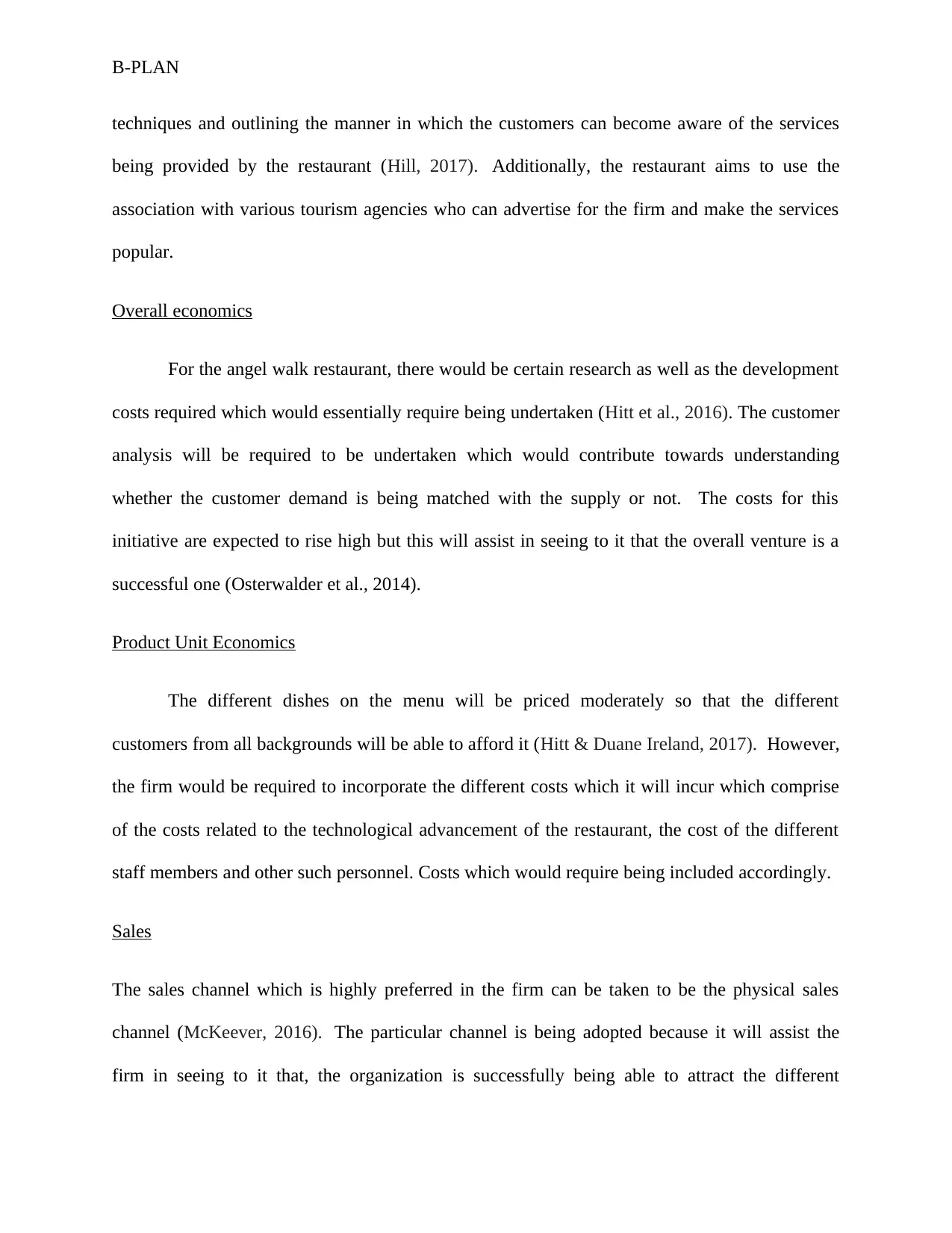
B-PLAN
techniques and outlining the manner in which the customers can become aware of the services
being provided by the restaurant (Hill, 2017). Additionally, the restaurant aims to use the
association with various tourism agencies who can advertise for the firm and make the services
popular.
Overall economics
For the angel walk restaurant, there would be certain research as well as the development
costs required which would essentially require being undertaken (Hitt et al., 2016). The customer
analysis will be required to be undertaken which would contribute towards understanding
whether the customer demand is being matched with the supply or not. The costs for this
initiative are expected to rise high but this will assist in seeing to it that the overall venture is a
successful one (Osterwalder et al., 2014).
Product Unit Economics
The different dishes on the menu will be priced moderately so that the different
customers from all backgrounds will be able to afford it (Hitt & Duane Ireland, 2017). However,
the firm would be required to incorporate the different costs which it will incur which comprise
of the costs related to the technological advancement of the restaurant, the cost of the different
staff members and other such personnel. Costs which would require being included accordingly.
Sales
The sales channel which is highly preferred in the firm can be taken to be the physical sales
channel (McKeever, 2016). The particular channel is being adopted because it will assist the
firm in seeing to it that, the organization is successfully being able to attract the different
techniques and outlining the manner in which the customers can become aware of the services
being provided by the restaurant (Hill, 2017). Additionally, the restaurant aims to use the
association with various tourism agencies who can advertise for the firm and make the services
popular.
Overall economics
For the angel walk restaurant, there would be certain research as well as the development
costs required which would essentially require being undertaken (Hitt et al., 2016). The customer
analysis will be required to be undertaken which would contribute towards understanding
whether the customer demand is being matched with the supply or not. The costs for this
initiative are expected to rise high but this will assist in seeing to it that the overall venture is a
successful one (Osterwalder et al., 2014).
Product Unit Economics
The different dishes on the menu will be priced moderately so that the different
customers from all backgrounds will be able to afford it (Hitt & Duane Ireland, 2017). However,
the firm would be required to incorporate the different costs which it will incur which comprise
of the costs related to the technological advancement of the restaurant, the cost of the different
staff members and other such personnel. Costs which would require being included accordingly.
Sales
The sales channel which is highly preferred in the firm can be taken to be the physical sales
channel (McKeever, 2016). The particular channel is being adopted because it will assist the
firm in seeing to it that, the organization is successfully being able to attract the different
Paraphrase This Document
Need a fresh take? Get an instant paraphrase of this document with our AI Paraphraser
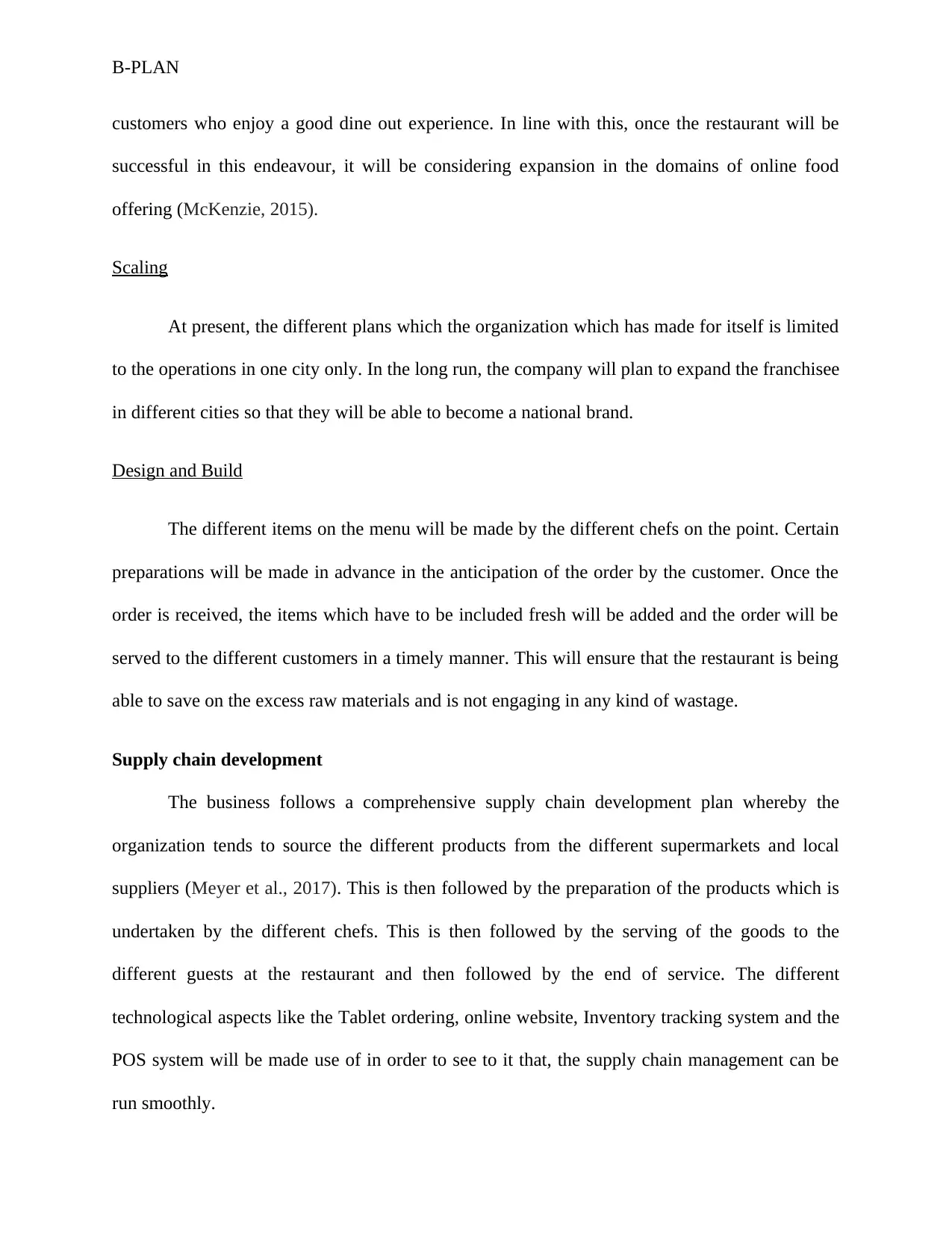
B-PLAN
customers who enjoy a good dine out experience. In line with this, once the restaurant will be
successful in this endeavour, it will be considering expansion in the domains of online food
offering (McKenzie, 2015).
Scaling
At present, the different plans which the organization which has made for itself is limited
to the operations in one city only. In the long run, the company will plan to expand the franchisee
in different cities so that they will be able to become a national brand.
Design and Build
The different items on the menu will be made by the different chefs on the point. Certain
preparations will be made in advance in the anticipation of the order by the customer. Once the
order is received, the items which have to be included fresh will be added and the order will be
served to the different customers in a timely manner. This will ensure that the restaurant is being
able to save on the excess raw materials and is not engaging in any kind of wastage.
Supply chain development
The business follows a comprehensive supply chain development plan whereby the
organization tends to source the different products from the different supermarkets and local
suppliers (Meyer et al., 2017). This is then followed by the preparation of the products which is
undertaken by the different chefs. This is then followed by the serving of the goods to the
different guests at the restaurant and then followed by the end of service. The different
technological aspects like the Tablet ordering, online website, Inventory tracking system and the
POS system will be made use of in order to see to it that, the supply chain management can be
run smoothly.
customers who enjoy a good dine out experience. In line with this, once the restaurant will be
successful in this endeavour, it will be considering expansion in the domains of online food
offering (McKenzie, 2015).
Scaling
At present, the different plans which the organization which has made for itself is limited
to the operations in one city only. In the long run, the company will plan to expand the franchisee
in different cities so that they will be able to become a national brand.
Design and Build
The different items on the menu will be made by the different chefs on the point. Certain
preparations will be made in advance in the anticipation of the order by the customer. Once the
order is received, the items which have to be included fresh will be added and the order will be
served to the different customers in a timely manner. This will ensure that the restaurant is being
able to save on the excess raw materials and is not engaging in any kind of wastage.
Supply chain development
The business follows a comprehensive supply chain development plan whereby the
organization tends to source the different products from the different supermarkets and local
suppliers (Meyer et al., 2017). This is then followed by the preparation of the products which is
undertaken by the different chefs. This is then followed by the serving of the goods to the
different guests at the restaurant and then followed by the end of service. The different
technological aspects like the Tablet ordering, online website, Inventory tracking system and the
POS system will be made use of in order to see to it that, the supply chain management can be
run smoothly.
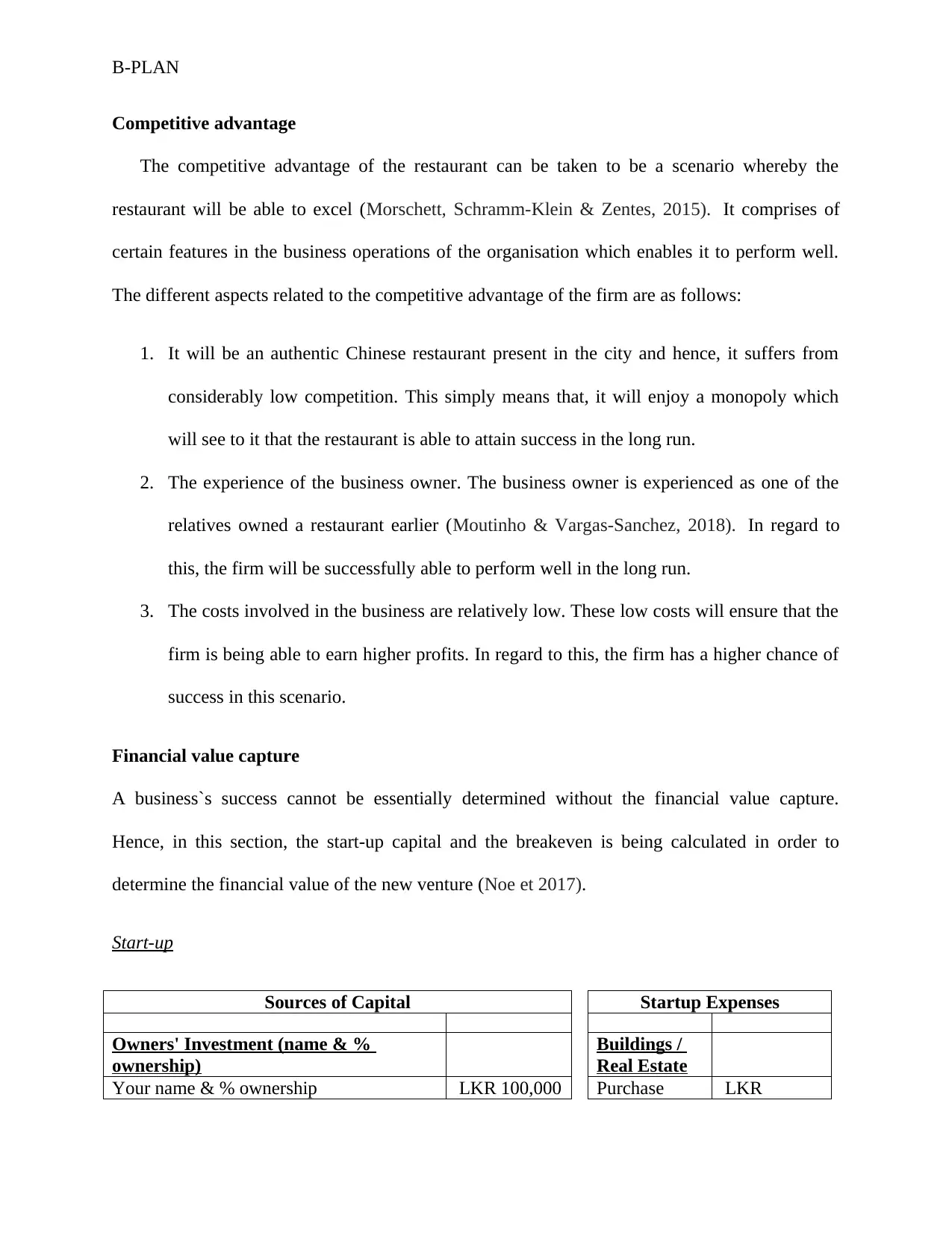
B-PLAN
Competitive advantage
The competitive advantage of the restaurant can be taken to be a scenario whereby the
restaurant will be able to excel (Morschett, Schramm-Klein & Zentes, 2015). It comprises of
certain features in the business operations of the organisation which enables it to perform well.
The different aspects related to the competitive advantage of the firm are as follows:
1. It will be an authentic Chinese restaurant present in the city and hence, it suffers from
considerably low competition. This simply means that, it will enjoy a monopoly which
will see to it that the restaurant is able to attain success in the long run.
2. The experience of the business owner. The business owner is experienced as one of the
relatives owned a restaurant earlier (Moutinho & Vargas-Sanchez, 2018). In regard to
this, the firm will be successfully able to perform well in the long run.
3. The costs involved in the business are relatively low. These low costs will ensure that the
firm is being able to earn higher profits. In regard to this, the firm has a higher chance of
success in this scenario.
Financial value capture
A business`s success cannot be essentially determined without the financial value capture.
Hence, in this section, the start-up capital and the breakeven is being calculated in order to
determine the financial value of the new venture (Noe et 2017).
Start-up
Sources of Capital Startup Expenses
Owners' Investment (name & %
ownership)
Buildings /
Real Estate
Your name & % ownership LKR 100,000 Purchase LKR
Competitive advantage
The competitive advantage of the restaurant can be taken to be a scenario whereby the
restaurant will be able to excel (Morschett, Schramm-Klein & Zentes, 2015). It comprises of
certain features in the business operations of the organisation which enables it to perform well.
The different aspects related to the competitive advantage of the firm are as follows:
1. It will be an authentic Chinese restaurant present in the city and hence, it suffers from
considerably low competition. This simply means that, it will enjoy a monopoly which
will see to it that the restaurant is able to attain success in the long run.
2. The experience of the business owner. The business owner is experienced as one of the
relatives owned a restaurant earlier (Moutinho & Vargas-Sanchez, 2018). In regard to
this, the firm will be successfully able to perform well in the long run.
3. The costs involved in the business are relatively low. These low costs will ensure that the
firm is being able to earn higher profits. In regard to this, the firm has a higher chance of
success in this scenario.
Financial value capture
A business`s success cannot be essentially determined without the financial value capture.
Hence, in this section, the start-up capital and the breakeven is being calculated in order to
determine the financial value of the new venture (Noe et 2017).
Start-up
Sources of Capital Startup Expenses
Owners' Investment (name & %
ownership)
Buildings /
Real Estate
Your name & % ownership LKR 100,000 Purchase LKR
⊘ This is a preview!⊘
Do you want full access?
Subscribe today to unlock all pages.

Trusted by 1+ million students worldwide
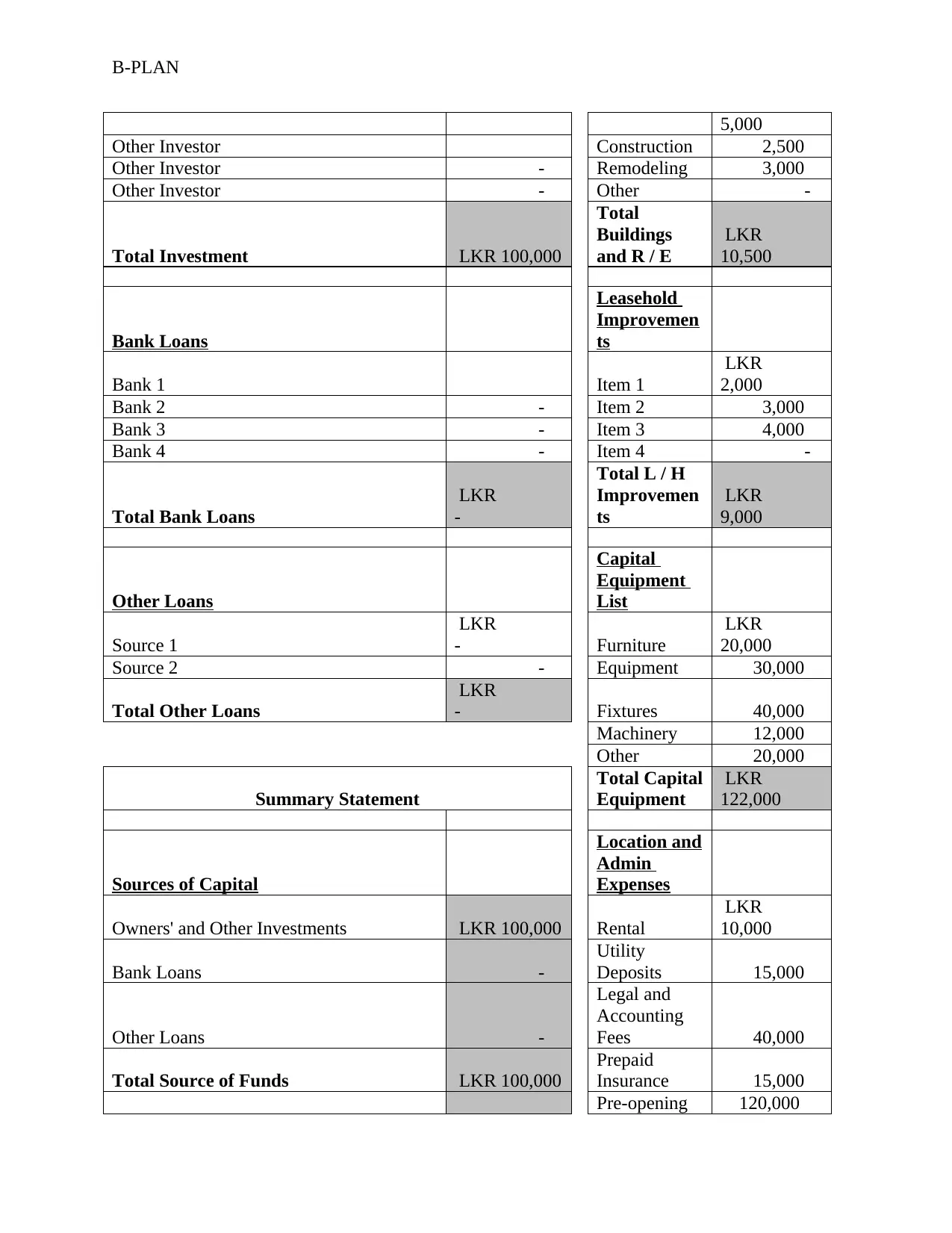
B-PLAN
5,000
Other Investor Construction 2,500
Other Investor - Remodeling 3,000
Other Investor - Other -
Total Investment LKR 100,000
Total
Buildings
and R / E
LKR
10,500
Bank Loans
Leasehold
Improvemen
ts
Bank 1 Item 1
LKR
2,000
Bank 2 - Item 2 3,000
Bank 3 - Item 3 4,000
Bank 4 - Item 4 -
Total Bank Loans
LKR
-
Total L / H
Improvemen
ts
LKR
9,000
Other Loans
Capital
Equipment
List
Source 1
LKR
- Furniture
LKR
20,000
Source 2 - Equipment 30,000
Total Other Loans
LKR
- Fixtures 40,000
Machinery 12,000
Other 20,000
Summary Statement
Total Capital
Equipment
LKR
122,000
Sources of Capital
Location and
Admin
Expenses
Owners' and Other Investments LKR 100,000 Rental
LKR
10,000
Bank Loans -
Utility
Deposits 15,000
Other Loans -
Legal and
Accounting
Fees 40,000
Total Source of Funds LKR 100,000
Prepaid
Insurance 15,000
Pre-opening 120,000
5,000
Other Investor Construction 2,500
Other Investor - Remodeling 3,000
Other Investor - Other -
Total Investment LKR 100,000
Total
Buildings
and R / E
LKR
10,500
Bank Loans
Leasehold
Improvemen
ts
Bank 1 Item 1
LKR
2,000
Bank 2 - Item 2 3,000
Bank 3 - Item 3 4,000
Bank 4 - Item 4 -
Total Bank Loans
LKR
-
Total L / H
Improvemen
ts
LKR
9,000
Other Loans
Capital
Equipment
List
Source 1
LKR
- Furniture
LKR
20,000
Source 2 - Equipment 30,000
Total Other Loans
LKR
- Fixtures 40,000
Machinery 12,000
Other 20,000
Summary Statement
Total Capital
Equipment
LKR
122,000
Sources of Capital
Location and
Admin
Expenses
Owners' and Other Investments LKR 100,000 Rental
LKR
10,000
Bank Loans -
Utility
Deposits 15,000
Other Loans -
Legal and
Accounting
Fees 40,000
Total Source of Funds LKR 100,000
Prepaid
Insurance 15,000
Pre-opening 120,000
Paraphrase This Document
Need a fresh take? Get an instant paraphrase of this document with our AI Paraphraser
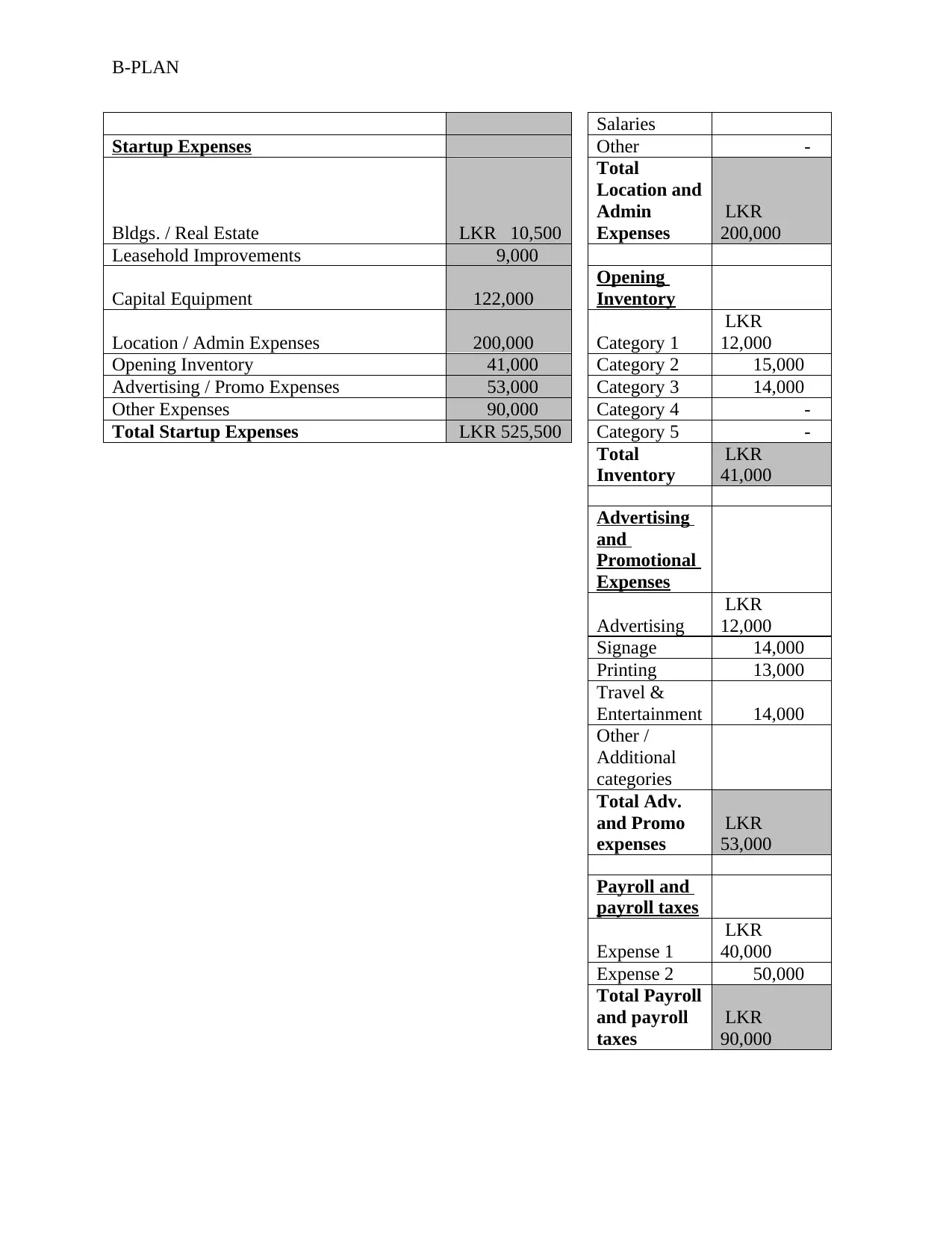
B-PLAN
Salaries
Startup Expenses Other -
Bldgs. / Real Estate LKR 10,500
Total
Location and
Admin
Expenses
LKR
200,000
Leasehold Improvements 9,000
Capital Equipment 122,000
Opening
Inventory
Location / Admin Expenses 200,000 Category 1
LKR
12,000
Opening Inventory 41,000 Category 2 15,000
Advertising / Promo Expenses 53,000 Category 3 14,000
Other Expenses 90,000 Category 4 -
Total Startup Expenses LKR 525,500 Category 5 -
Total
Inventory
LKR
41,000
Advertising
and
Promotional
Expenses
Advertising
LKR
12,000
Signage 14,000
Printing 13,000
Travel &
Entertainment 14,000
Other /
Additional
categories
Total Adv.
and Promo
expenses
LKR
53,000
Payroll and
payroll taxes
Expense 1
LKR
40,000
Expense 2 50,000
Total Payroll
and payroll
taxes
LKR
90,000
Salaries
Startup Expenses Other -
Bldgs. / Real Estate LKR 10,500
Total
Location and
Admin
Expenses
LKR
200,000
Leasehold Improvements 9,000
Capital Equipment 122,000
Opening
Inventory
Location / Admin Expenses 200,000 Category 1
LKR
12,000
Opening Inventory 41,000 Category 2 15,000
Advertising / Promo Expenses 53,000 Category 3 14,000
Other Expenses 90,000 Category 4 -
Total Startup Expenses LKR 525,500 Category 5 -
Total
Inventory
LKR
41,000
Advertising
and
Promotional
Expenses
Advertising
LKR
12,000
Signage 14,000
Printing 13,000
Travel &
Entertainment 14,000
Other /
Additional
categories
Total Adv.
and Promo
expenses
LKR
53,000
Payroll and
payroll taxes
Expense 1
LKR
40,000
Expense 2 50,000
Total Payroll
and payroll
taxes
LKR
90,000
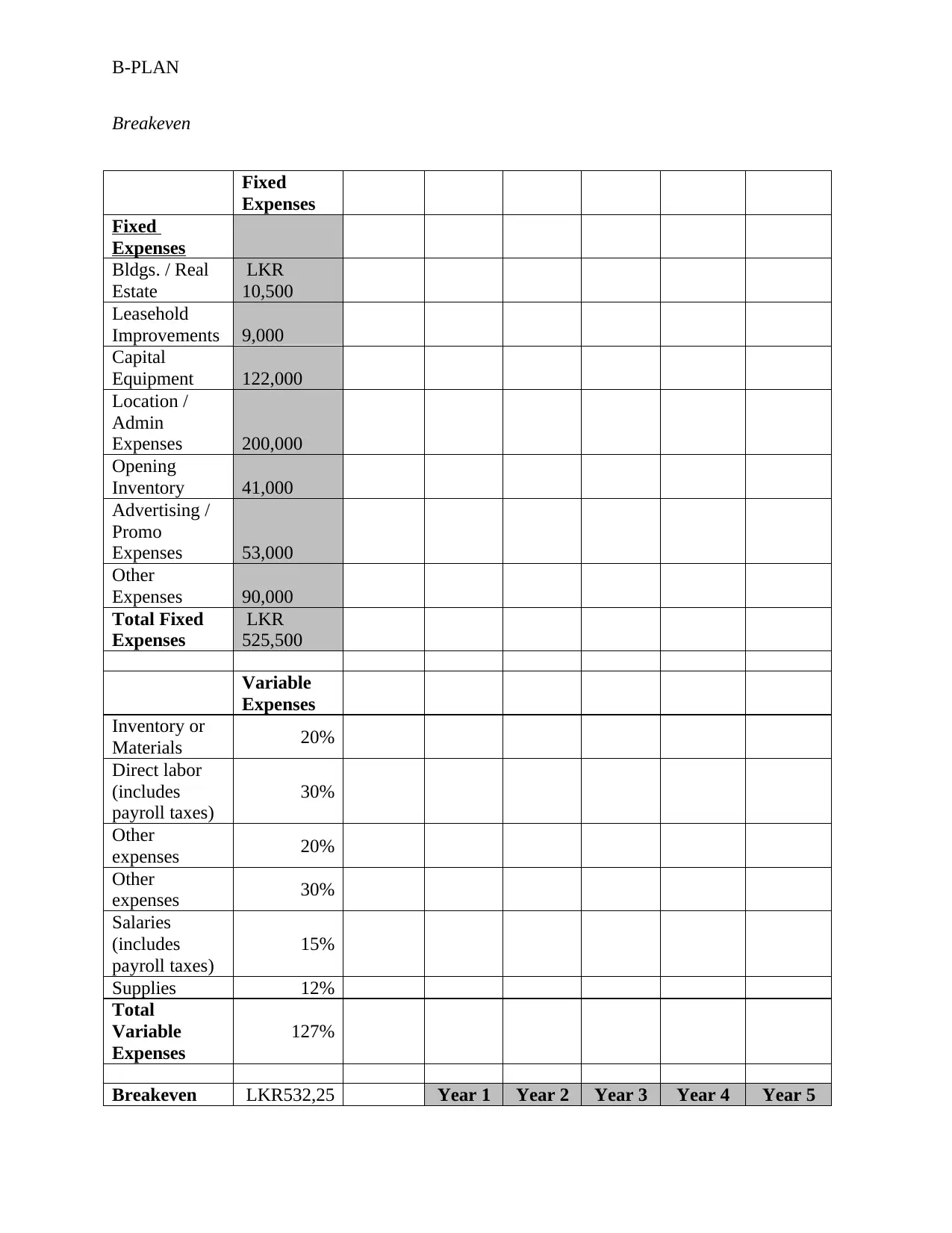
B-PLAN
Breakeven
Fixed
Expenses
Fixed
Expenses
Bldgs. / Real
Estate
LKR
10,500
Leasehold
Improvements 9,000
Capital
Equipment 122,000
Location /
Admin
Expenses 200,000
Opening
Inventory 41,000
Advertising /
Promo
Expenses 53,000
Other
Expenses 90,000
Total Fixed
Expenses
LKR
525,500
Variable
Expenses
Inventory or
Materials 20%
Direct labor
(includes
payroll taxes)
30%
Other
expenses 20%
Other
expenses 30%
Salaries
(includes
payroll taxes)
15%
Supplies 12%
Total
Variable
Expenses
127%
Breakeven LKR532,25 Year 1 Year 2 Year 3 Year 4 Year 5
Breakeven
Fixed
Expenses
Fixed
Expenses
Bldgs. / Real
Estate
LKR
10,500
Leasehold
Improvements 9,000
Capital
Equipment 122,000
Location /
Admin
Expenses 200,000
Opening
Inventory 41,000
Advertising /
Promo
Expenses 53,000
Other
Expenses 90,000
Total Fixed
Expenses
LKR
525,500
Variable
Expenses
Inventory or
Materials 20%
Direct labor
(includes
payroll taxes)
30%
Other
expenses 20%
Other
expenses 30%
Salaries
(includes
payroll taxes)
15%
Supplies 12%
Total
Variable
Expenses
127%
Breakeven LKR532,25 Year 1 Year 2 Year 3 Year 4 Year 5
⊘ This is a preview!⊘
Do you want full access?
Subscribe today to unlock all pages.

Trusted by 1+ million students worldwide
1 out of 17
Related Documents
Your All-in-One AI-Powered Toolkit for Academic Success.
+13062052269
info@desklib.com
Available 24*7 on WhatsApp / Email
![[object Object]](/_next/static/media/star-bottom.7253800d.svg)
Unlock your academic potential
Copyright © 2020–2025 A2Z Services. All Rights Reserved. Developed and managed by ZUCOL.




